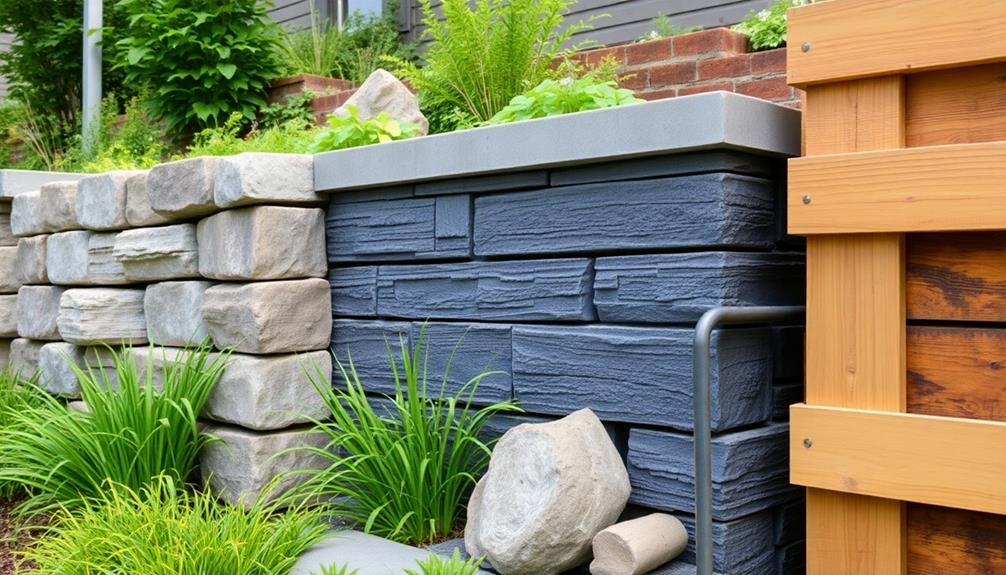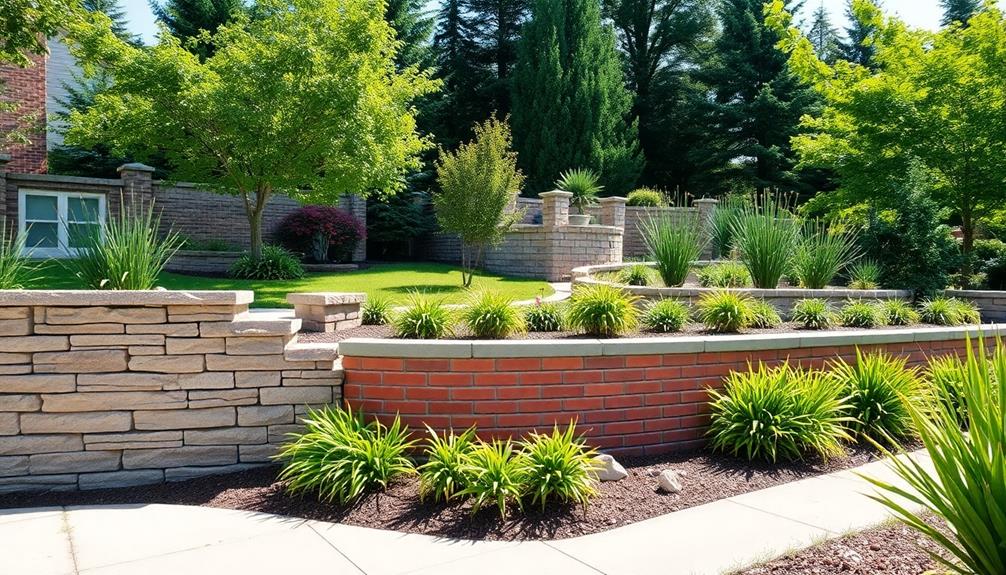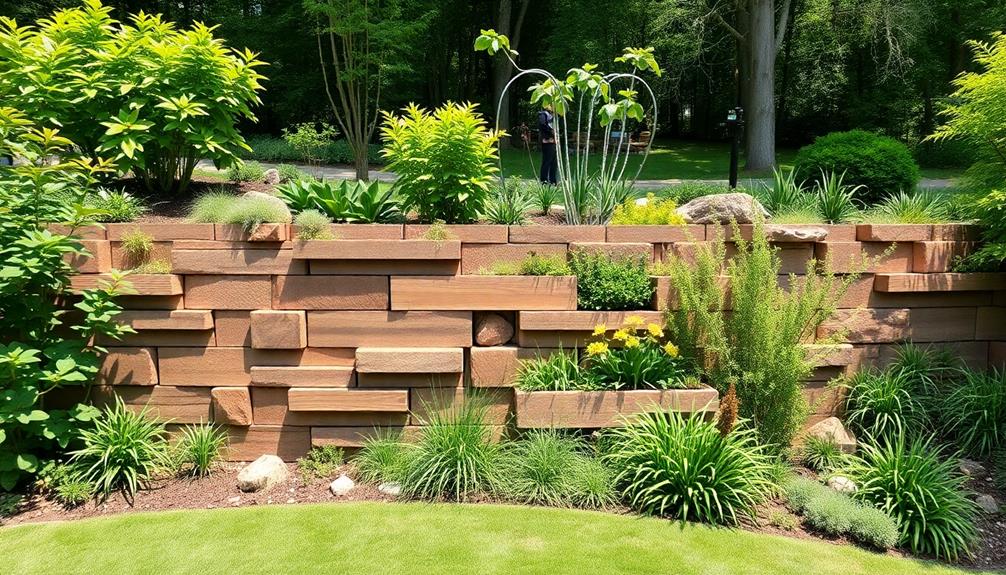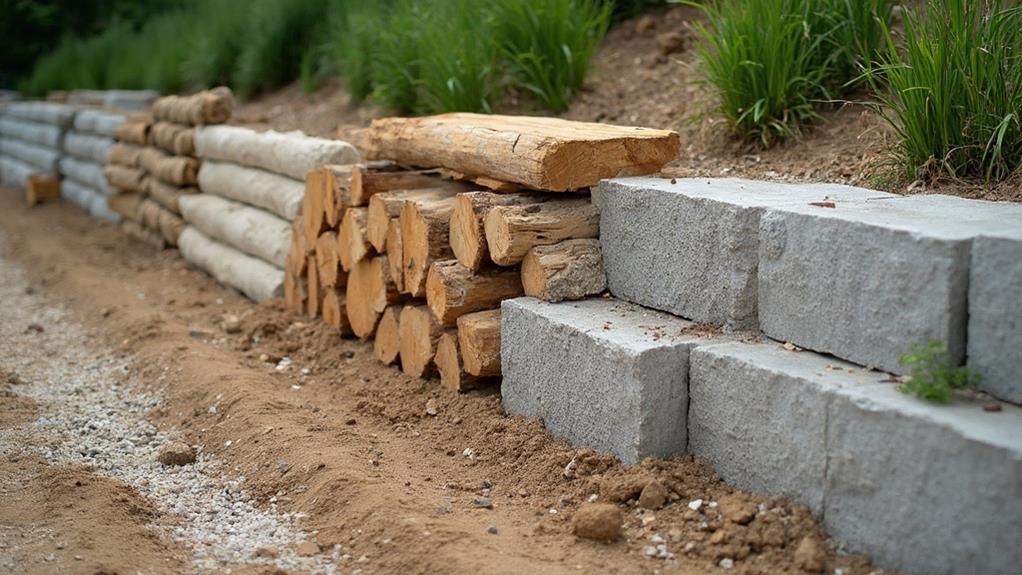Retaining wall construction utilizes various materials, each offering unique benefits in structural integrity, aesthetic appeal, and environmental responsibility. Common options include concrete blocks for their durability and cost-effectiveness, natural stone for timeless beauty, and timber for its versatile use in residential designs. Sustainable and eco-friendly alternatives such as recycled concrete and sustainable timber contribute to resource conservation and reduced maintenance needs. Additionally, eco-friendly stone and innovative materials like permeable pavers and hempcrete provide further choices, balancing durability with ecological consciousness. Exploring these materials can lead to more informed selections for your retaining wall project, enriching both functionality and sustainability.
Table of Contents
ToggleWalls Contractor Highlights
- Concrete blocks offer strength, durability, and cost-effectiveness for retaining wall construction.
- Natural stone provides a timeless aesthetic and long-lasting durability suitable for retaining walls.
- Timber is a versatile, lightweight material that blends well with natural surroundings.
- Recycled concrete minimizes environmental impact while retaining strength and functionality.
- Permeable pavers help maintain water cycle and local ecosystem health in retaining wall projects.
Primary Material Options

When considering primary materials for retaining wall construction, concrete blocks stand out due to their strength, durability, and ease of installation, making them an efficient choice for both small and large-scale projects. Natural stone, with its timeless aesthetic and inherent durability, offers a visually appealing option that blends seamlessly into landscapes, though it often requires more intricate craftsmanship.
Distinctly, the natural aspect of stone makes it alluring because each stone is unique, providing a one-of-a-kind appearance as highlighted in Boulder Retaining Walls. Timber, characterized by its versatility and natural appearance, is particularly suitable for projects that demand adaptability in design while providing a cost-effective solution, especially in areas where environmental integration is desired.
Concrete Blocks Benefits
Among the various materials available for retaining wall construction, concrete blocks stand out due to their numerous benefits. Offering exceptional strength and durability, concrete blocks are a preferred choice for both residential and commercial projects, guaranteeing structural integrity over an extended period. Their capacity to withstand significant pressure gradients makes them an outstanding candidate for retaining substantial soil loads, thereby safeguarding landscapes and infrastructural elements.
In addition to their robustness, the versatility of concrete blocks offers substantial architectural flexibility. Available in various sizes, shapes, and finishes, they can easily be tailored to match the aesthetic demands of any given site, providing a cohesive visual integration with existing structures. This adaptability confirms that concrete blocks can accommodate varying wall designs, from basic functional structures to elaborate, visually appealing walls that enhance property value.
Furthermore, the installation process of concrete block retaining walls is relatively straightforward, which reduces labor costs and time commitments. Prefabricated blocks are engineered for easy alignment and secure stacking, accelerating construction timelines while still maintaining high structural standards. This efficiency makes concrete blocks an economical choice for those seeking a reliable and cost-effective solution for retaining wall construction, fostering a sense of confidence and trust within the community.
Natural Stone Appeal
Natural stone consistently offers a timeless and elegant appeal in retaining wall construction, positioning itself as a primary material option for those seeking both durability and aesthetic charm. This material is favored for its ability to seamlessly blend natural beauty and robust structural performance, creating retaining walls that do not only serve a functional purpose but also enhance the visual landscape.
The inherent strength of natural stone guarantees longevity, while its variety in color, texture, and form allows for a personalized touch that reflects individual tastes and complements existing environmental features.
Furthermore, natural stone is known for its ecological benefits, as it is sourced from the earth with minimal processing involved, consequently retaining its natural integrity. The diverse array of stones available, including granite, limestone, and sandstone, offers versatility in design while adhering to sustainable building practices.
For those in pursuit of an enduring connection to the Earth's elements, natural stone presents an inviting opportunity to integrate this connection into personal or community spaces. The classic aesthetic and practical benefits make natural stone a compelling choice for environmentally-conscious individuals and communities seeking to create harmonious and enduring outdoor environments.
Timber Versatility Uses
Timber stands out as a versatile material option in retaining wall construction, appreciated for its accessibility, ease of use, and aesthetic warmth. Its adaptability is not merely limited to aesthetic qualities but is augmented by practical advantages that cater to a community seeking harmonious integration of nature with infrastructure.
Timber's prudent use in retaining walls brings a sense of tradition combined with modern sensibility, providing a nurturing environment for both landscapes and lifestyles.
Consider these distinct applications:
- Residential Beautification: Timber's natural color and texture complement gardens and homes, offering appealing visual continuity that draws connections between indoor and outdoor spaces, fostering a sense of belonging.
- Stability and Strength: Engineered timber is renowned for its remarkable strength-to-weight ratio, making it an effective option for both single-level and tiered retaining wall systems that demand reliable performance over time.
- Environmental Harmony: Responsibly sourced timber provides an environmentally friendly choice, aligning with community values of sustainable living and conserving natural resources.
- Ease of Installation: Its lightweight nature simplifies the construction process, making it accessible for DIY enthusiasts and professionals alike, encouraging widespread adoption and community involvement.
Benefits

The materials chosen for retaining wall construction offer distinct advantages that are essential in modern architectural and landscaping projects. Boulder walls, for example, effectively retain soil and prevent erosion on complex terrains. By selecting environmentally friendly materials, builders can substantially reduce the overall ecological footprint of a project.
These materials, such as those used in boulder walls, also benefit from enhanced durability and longevity, ensuring the structures can withstand environmental pressures over time. In addition, a cost-effectiveness analysis highlights how these durable materials can be economically beneficial, and their diverse aesthetic design options allow for creative, visually appealing solutions tailored to specific project requirements.
Environmental Impact Reduction
Often overlooked in retaining wall projects, the choice of materials can vastly reduce the environmental impact of construction. Selecting eco-friendly materials not only fosters a sense of collective responsibility but also embodies a pivotal step towards sustainable construction practices. Builders, architects, and property owners who value environmental preservation will find that opting for such materials aligns with a broader ecological narrative.
There are several materials available that help achieve this goal:
- Recycled Concrete and Aggregates: Utilizing recycled components not only reduces landfill waste but also decreases the demand for virgin materials. This choice resonates with environmental advocacy by minimizing resource extraction.
- Natural Stone: Harvested responsibly, natural stone offers not only durability but also a minimal carbon footprint compared to man-made materials, enhancing the ecological value.
- Wood: Specifically, timber sourced from sustainable forests, when used in retaining walls, contributes to carbon sequestration and supports sustainable forestry practices.
- Fly Ash or Slag Cement: These industrial byproducts can replace traditional cement components, effectively reducing greenhouse gas emissions and promoting waste reuse.
Durability and Longevity
Choosing eco-friendly materials not only serves an environmental purpose but can also markedly enhance the durability and longevity of retaining walls. By utilizing sustainable materials such as recycled concrete, natural stone, and certain types of timbers, the structural integrity of retaining walls can be greatly fortified, offering an extended lifespan and reduced need for maintenance. These materials are inherent in their ability to resist natural decay, weathering, and other environmental stressors, ensuring that the walls they construct stand resilient against the test of time.
Moreover, the inherent characteristics of these materials contribute to their robustness; natural stone, for instance, boasts exceptional compressive strength and weather resistance, making it a valuable asset in constructing long-lasting structures. Similarly, recycled concrete retains the attributes of traditional concrete but adds the benefit of reusability, thereby extending its utility and minimizing environmental impact.
Carefully selecting materials that harmonize with their environment is a vital consideration for cohesive and sustainable community development. Incorporating these materials, therefore, not only aligns with eco-conscious practices but also guarantees that retaining walls function effectively over decades, strengthening their role in landscape management and continuously contributing to the safety and aesthetics of shared spaces.
Cost-Effectiveness Analysis
Investing in eco-friendly materials for retaining wall construction presents significant cost-effectiveness benefits. Modern construction not only considers initial financial outlay but also the long-term value proposition.
Retaining walls built with sustainable materials offer numerous cost-effective features that attract communities keen on responsible consumption and safeguarding future resources. Engineers and builders increasingly acknowledge the financial wisdom behind choosing eco-friendly materials, which reflect their appreciation for innovative, sustainable practices.
- Reduced Maintenance Costs: Eco-friendly materials typically require less upkeep due to their durability and resistance to natural elements, mitigating future repair expenses.
- Energy Efficiency: The production process of sustainable materials often involves less energy consumption, translating to reduced carbon footprints and cost savings over time.
- Increased Property Value: Properties that integrate green building practices often witness an uptick in market value, appealing to environmentally conscious buyers and investors.
- Regulatory Compliance: Utilizing eco-conscious materials secures adherence to environmental regulations, helping to avoid penalties and align with governmental sustainability incentives.
These benefits underscore a broader understanding that initial investments in eco-friendly materials foster long-term economic advantages. By prioritizing sustainability, communities can guarantee monetary savings while contributing to a globally conscious approach to construction.
Aesthetic Design Options
Beyond cost-effectiveness, choosing eco-friendly materials for retaining wall construction substantially enhances aesthetic design options, offering considerable benefits to project stakeholders. Incorporating materials like recycled concrete, sustainably sourced timber, and environmentally sensitive composites not only aligns with ecological principles but also allows for a diverse range of design possibilities, meeting various aesthetic preferences. Their natural textures and hues offer versatility, enabling architects and landscapers to seamlessly integrate the retaining walls into the surrounding environment or highlight them as architectural features.
Utilizing eco-friendly materials supports the creation of designs that resonate with contemporary aesthetic values, appealing to communities that prioritize sustainability while fostering a sense of belonging. These materials provide the flexibility needed to achieve visually appealing designs that reflect both personal taste and broader community ethos.
Moreover, the ability to customize these materials enhances the overall aesthetic appeal and project uniqueness. For stakeholders, this translates into harmonizing beauty with sustainability, creating spaces that are not only functional but also contribute positively to the overall landscape design. This confluence of ecological responsibility and aesthetic diversity guarantees that retaining wall projects are both forward-thinking and visually satisfying, aligning with modern community aspirations.
Alternative Eco-Friendly Materials

In the pursuit of more sustainable construction practices, alternative eco-friendly materials are being explored for retaining wall applications, encompassing options such as recycled concrete, sustainable timber, and eco-friendly stone. Each material not only serves to reduce environmental impact but also adheres to specific functional and aesthetic criteria. The table below outlines key considerations associated with these materials:
| Material Type | Benefits | Considerations |
|---|---|---|
| Recycled Concrete | Reduces landfill waste | Requires careful sourcing |
| Sustainable Timber | Renewable and biodegradable | Potential for limited lifespan |
| Eco-friendly Stone | Minimal environmental impact | May have higher initial cost |
As industry stakeholders continue to emphasize ecological responsibility, understanding the specific attributes of these materials is crucial.
Recycled Concrete Options
A notable advancement in eco-friendly construction materials is the use of recycled concrete for retaining walls. This innovative approach not only reinforces the structural integrity of retaining walls but also profoundly contributes to sustainable development by repurposing construction waste.
Recycled concrete aggregates provide an effective solution for reducing landfill usage and minimizing the carbon footprint associated with new concrete production. By choosing recycled concrete, builders join a growing community committed to environmental stewardship and resource efficiency.
Environmental Impact: Recycled concrete reduces the demand for virgin resources and decreases greenhouse gas emissions during material production.
Cost-Effectiveness: Using recycled materials can lower construction costs as it minimizes expenses associated with waste disposal and the procurement of raw materials.
Durability: Recycled concrete retains much of the strength and longevity seen in traditional concrete, making it a reliable material for retaining walls.
Versatility: This material can be fashioned into different forms and integrated with natural aesthetics, offering diverse applications in various landscaping and architectural designs.
Sustainable Timber Choices
While recycled concrete offers a robust eco-friendly option for retaining wall construction, sustainable timber presents another compelling alternative. Increasingly embraced by environmentally conscious communities, sustainable timber choices derive from responsibly managed forests that guarantee minimal ecological footprint through cyclical regeneration and conscientious harvesting methods. This approach resonates deeply with those who aspire to harmonize with nature, subtly reminding them of their role in a global community dedicated to the preservation of natural resources.
Sustainable timber, such as bamboo or certified hardwood from entities like the Forest Stewardship Council (FSC), exemplifies durability and aesthetic appeal. Its use not only results in structurally sound retaining walls but also contributes to carbon sequestration, a vital process in combating climate change. Bamboo, renowned for its rapid growth, presents an especially viable option due to its ability to regenerate quickly, ensuring a perpetually abundant supply without long-term ecological disturbances.
This choice aligns with broader sustainability goals, encouraging the integration of natural elements into constructed environments, which strengthens the bond between the built world and its natural surroundings. Community landscapes flourish aesthetically and ethically, offering an inviting habitat for future generations passionate to embrace sustainable living practices.
Eco-friendly Stone Variants
How can builders strike a balance between structural integrity and environmental awareness in retaining wall construction? By employing eco-friendly stone variants, a refined approach is achieved, ensuring sturdy structures while preserving ecological sanctity. These alternatives offer a harmonious blend of durability and sustainability.
Recycled Concrete Blocks – These blocks, sourced from demolished structures, provide an excellent option that reduces landfill waste. They deliver comparable strength and thermal mass as new concrete, creating robust walls with considerably less environmental impact.
Locally Sourced Stone – Utilizing materials from nearby quarries not only supports regional economies but also minimizes the carbon footprint associated with transportation. Additionally, these stones often possess natural characteristics suited to local climate conditions.
Permeable Pavers – This innovative material allows water to pass through, reducing surface runoff and promoting ground recharge. It assists in maintaining the natural water cycle, which is crucial for sustaining local ecosystems.
Hempcrete Blocks – Formed from hemp fibers, lime, and water, hempcrete provides a lightweight yet sturdy material with natural insulating properties. Its production emphasizes eco-friendliness, using less energy and capturing more carbon dioxide than it emits.
Selecting these eco-friendly materials allows builders to construct retaining walls that stand resilient while fostering a deeper connection with the environment.
Walls Contractor FAQ
What Are the Typical Costs Associated With Different Retaining Wall Materials?
In evaluating constructing retaining walls, costs fluctuate considerably based on material choice. Opting for concrete can range from $30-$50 per square foot, while natural stone or timber may vary, aligning with budget constraints and aesthetic preferences.
How Do You Determine the Longevity of Retaining Wall Materials?
Evaluating the longevity of retaining wall materials necessitates assessing factors like environmental conditions, material composition, installation quality, and maintenance practices. Acknowledging these variables allows communities to make informed decisions, fostering durability and inclusivity in their shared spaces.
What Are the Best Maintenance Practices for Retaining Wall Materials?
To guarantee robust longevity of retaining wall materials, conduct regular inspections, promptly address structural weaknesses, safeguard proper drainage, and remove vegetation. Establishing routine maintenance cultivates trust and solidarity within communities reliant on these essential structures.
How Do Climate Conditions Impact the Choice of Retaining Wall Materials?
Climate conditions noticeably affect selecting retaining wall materials, requiring proactive engagement with geographical challenges. Consideration of temperature fluctuations, precipitation levels, and soil stability guarantees durability and resilience, fostering a shared commitment to community safety and environmental stewardship.
Are There Specific Permits Required for Using Particular Retaining Wall Materials?
Permits for retaining wall materials depend on local regulations, which can vary dramatically. Compliance with building codes guarantees safety and sustainability. Consulting with local authorities is vital to understand specific prerequisites for material usage in construction projects.







